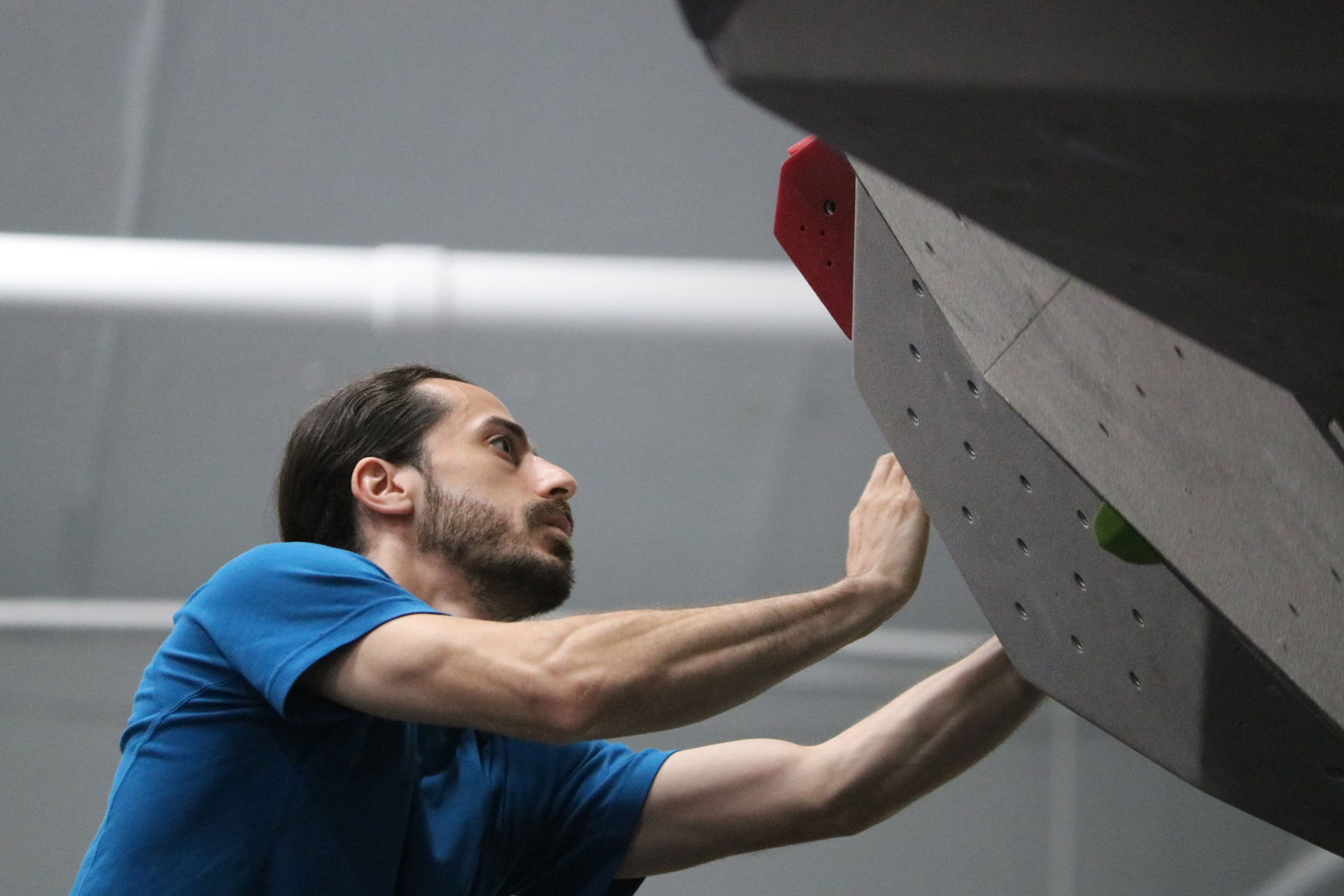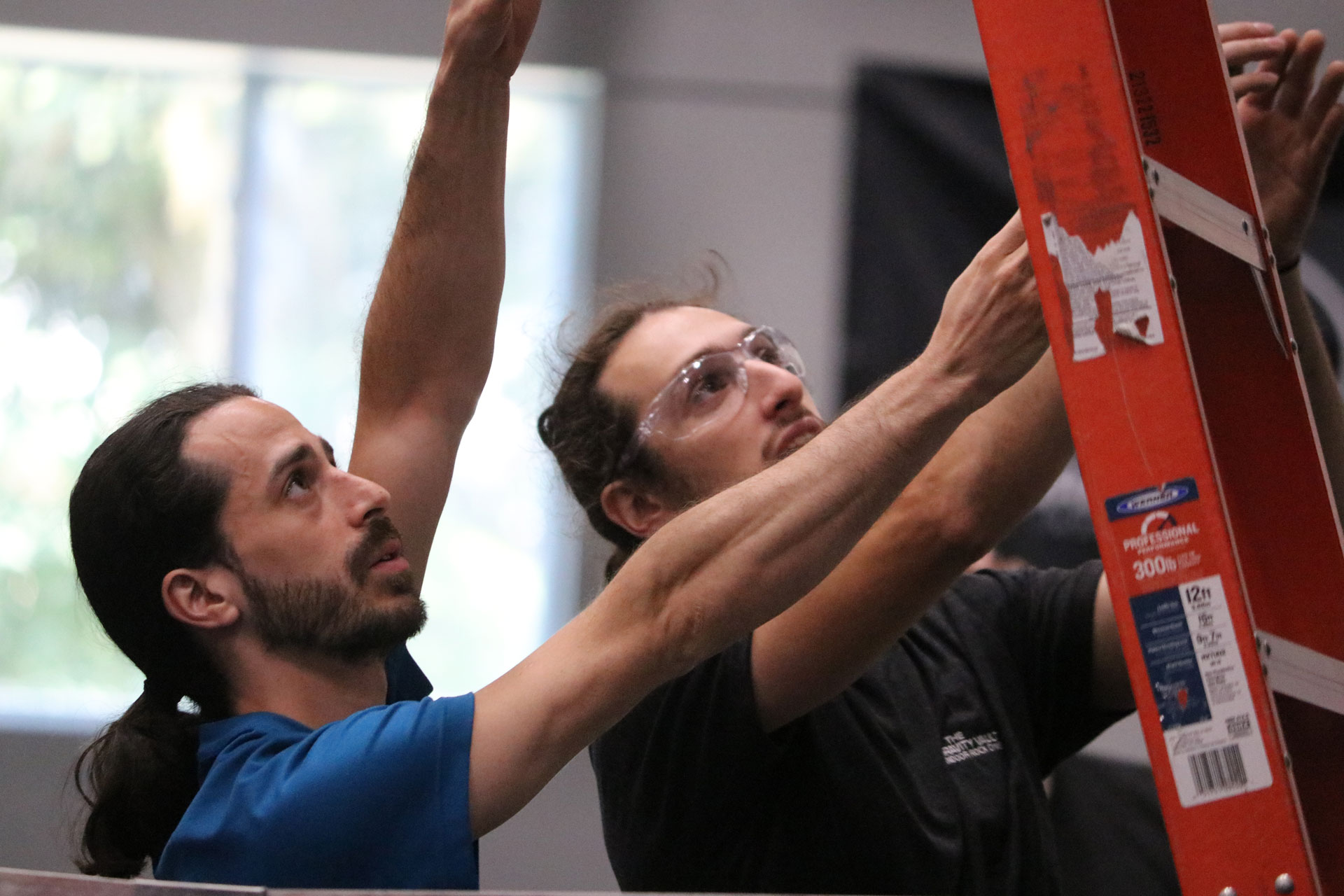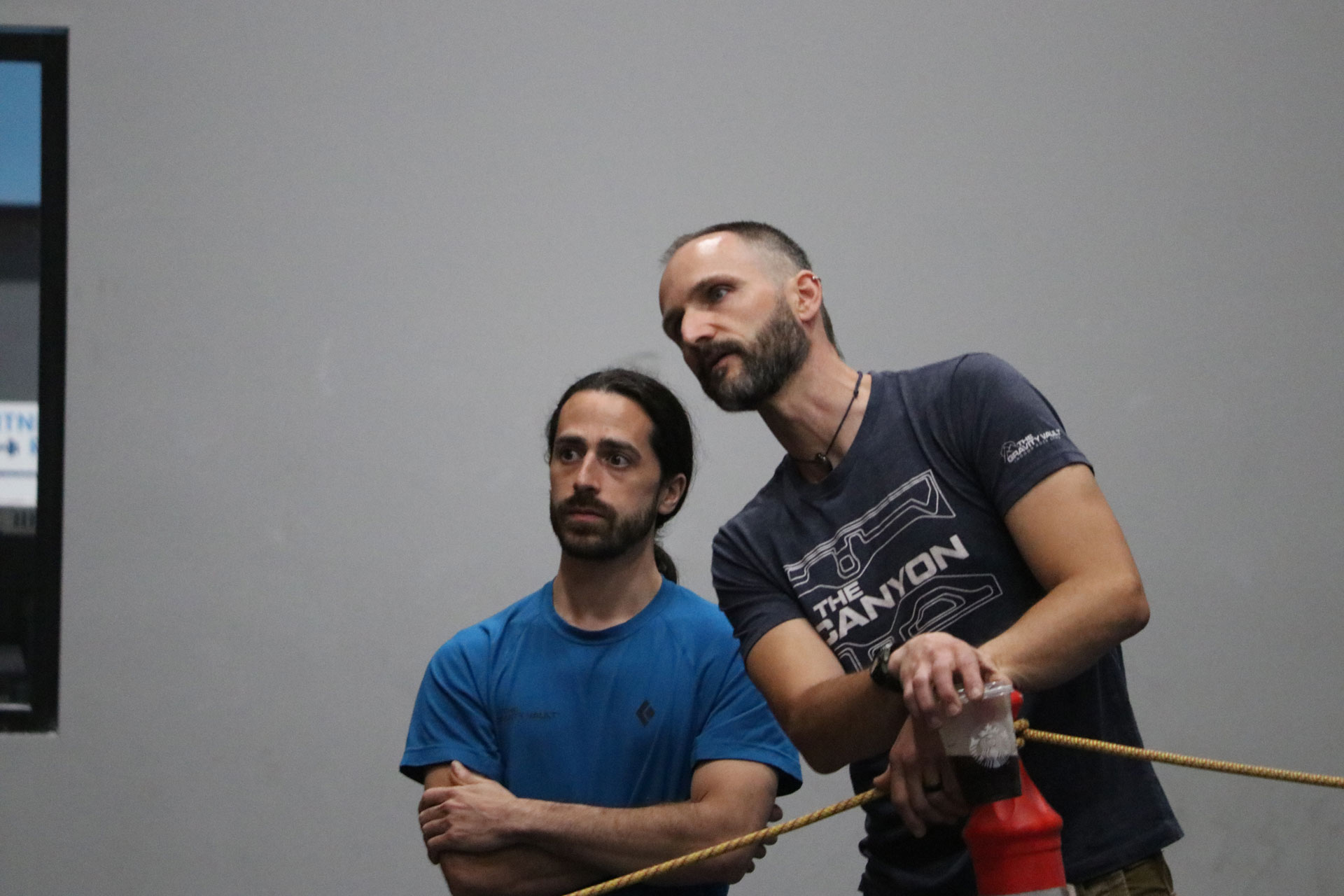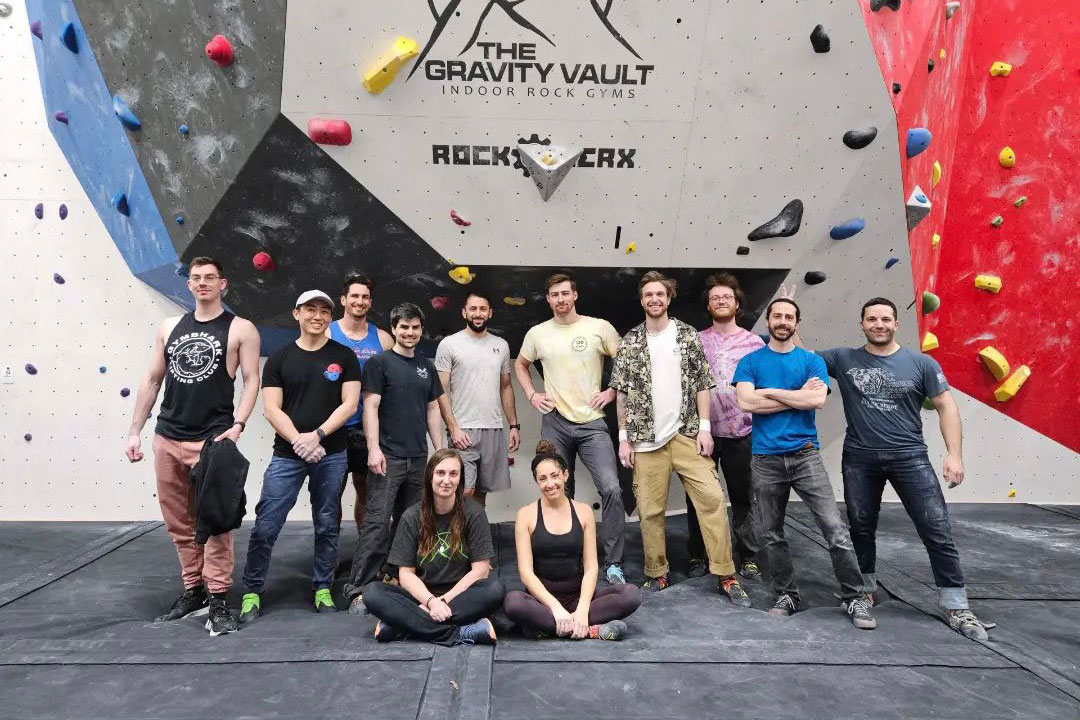
Name: Kevin McLean
Title: Head Routesetter, The Gravity Vault Upper Saddle River
Location: Upper Saddle River, New Jersey
WOMPA: Tell me a little about yourself, your climbing, your routesetting work.
MCLEAN: My name is Kevin McLean, I’m the Head Routesetter for The Gravity Vault Upper Saddle River. I’ve been climbing for around twelve years now and routesetting for a little over six years. I’m mostly a rope climber; I love sport climbing, trad climbing…Funny enough, I’m not against bouldering at all, but I don’t even own a crash pad.
Since you’re more into sport climbing, is that focus your preference for routesetting, as well?
Routesetting is obviously related to climbing, but it’s also a different practice of its own. When it comes to routesetting, I don’t discriminate one way or the other. I just really love getting up on the rope and setting awesome, flowy routes just as much as I love getting intricate, flowy movement out of boulders. And I think it’s good to have a balance, you know? It’s interesting to think about some people who work at bouldering-only gyms, especially if they try to get into the competition scene, where ultimately you’ll have to do both practices.
It does seem like styles of routesetting can vary so much by location. Why is it important to think beyond one’s own setting bubble?
I think that’s a really important role for the head setter. I always think of a gym like an art gallery and the head setter is almost like the curator. If you’re a beginning climber and you come into The Gravity Vault where I work, the routes in our gym will shape you as a climber. I think that’s a really important thing to keep in mind, so you have that diversity in your setting, helping people become more well-rounded and well-exposed climbers.
Do you think being a head setter, or just being a setter in general, has changed your relationship with climbing?
I would say it’s definitely changed my relationship with climbing. At first, as a general routesetter, you’ll come in with a little bit more individuality in your setting and your style, and you can afford to do so because it’s balanced out across a team. Once you’re in a head setter position, you have to be that one who finds the balance for the community. Because [as a setting team], you’re not just setting for yourself, and you’re not just climbing for yourself.
I’ve definitely noticed how I’ve changed as a climber, since working as a setter. I always have to force myself to climb in different styles and understand movement and be able to build my skills, in order to then give a better experience to the members through my setting.

Yeah, I’ve heard some people feel that since they’ve become a setter it both restricts their creativity on the wall but also enhances it because they have to think about what everybody else wants to climb, as opposed to just their own preferences. So, do you think being a head setter makes you more creative or stricter in your setting?
I think it makes me more creative. And I think a very important trait to keep as a head setter is that you have to have an open mind. It might be my job to make sure the gym is getting what it needs, but you have to make sure that you’re not influencing other setters to set more in your style and what you like. You have to make sure that it’s good for the gym.
There have been times when I’m talking to setters and I’ll notice something and I’ll keep it to myself. For example, I may think, “I personally would change that,” but I don’t say it because I don’t want to let my preferences kind of “bleed” into their routes. So, I always like to sit back on that sort of stuff and let the routes get forerun, get some feedback, and kind of let the “group think” have more of a say.
But one other thing I would say about how working in the industry and being a routesetter has changed me as a climber is that I definitely need to manage my time differently. For example, trying to balance out energy consumption is a big issue. When you’re setting almost full-time, hobby climbing sometimes gets compromised because you’re giving so much time and energy to your job. At the end of a day, it’s one of those things where you’re like, “All right, well, I’ve been working all day, I’m not going to stick around to do my own session.”
You’ve talked about holding back on critiques, but would you have any advice, especially for beginning setters, on how to deal with criticism?
I think, personally, I always take criticism, and I take it well. And I think you always have to listen to it. You can be kind of pragmatic about it. You hear the criticism, you take it for what it is and apply it to the situation. I think you can make that determination of, “Okay, that’s valid criticism. Let me take it into account and put my head around it, maybe even implement the change and see the difference.”
In comparison, sometimes you get criticism that isn’t so useful and you can dismiss it. But definitely for beginners, I think it’s really important to stay open-minded and interpret criticism and take the time to determine its value. Because you don’t want to be dogmatic about setting either. It’s important to stay humble.

Could you describe the process it took to become a head routesetter?
If you’re looking to be a head setter, I think first and foremost you have to have a strong work ethic. Setting as a job is very labor intensive, but if you’re trying to be a head setter, you’re probably already familiar with that fact.
I think it’s important to get a lot of exposure and see what other gyms are doing. See how other routesetters approach a set. Do clinics if you can.
Personality wise, I think as a head setter it’s really important to be a person who’s willing to compromise and has good people skills. Because, again, people’s hearts and souls are in their routes. Having the ability to grace a conversation—where you can give somebody criticism but also help shape them into a better routesetter and not diminish their signature or their spirits—is invaluable. Being able to manage and multi-task, as far as administrative work, is also important.
The first thing I should’ve mentioned is you have to be passionate about this sort of work.
Again, it’s not just your job, and it’s not just you setting routes. You’re creating an experience for the members here. You’re creating this visual and experiential art. You want to be able to give the community something special. You want to have that kid come into the gym for the first time and have it click with them the way it did with you when you became a climber. I think that’s such an important part of the job to me. I try to think outside myself.
In what other ways do you try to give the community something special?
I also run a program at Upper Saddle River called “Setting Club,” where I strip a big section of the wall and get ladders, holds and hand tools out, and I actually give our members an opportunity to come in and set their own routes.
I usually stay hands-off; in a clinic, I would teach you routesetting skills, but in a setting club it’s more of a social event. It’s interesting to see how people’s attitudes change once they’re about to put a hold on the wall. Because they realize that their climb is going to stay there and be climbed by other people, and suddenly everything changes in that moment for them.
How has a club like this one changed the community?
After taking on the head setting role and kind of finding the groove with the workflow and all that, I started to have an interest in looking to other places and seeing what other things I can help with within the gym, whether it be through business or the community. I figured the club would be an awesome way to engage the community.
I’m just responding to what I hear from the members. I overheard a lot of members mention how they’d love to set, and so I thought, “Let’s make it happen.” Since then, there’s been a hugely positive response. After the last one I did, I took pictures of everybody and what they set so I could do member highlights on our Instagram. The club has been a great way of providing community engagement and also just responding to the community. It’s free for members, but we do have to limit participation.
Typically I strip the Walltopia walls, because it’s much more challenging to use set-screws and to teach people how to navigate the granite walls. We ended up deciding on having twelve people in pairs, where each person or team would make a route. Then me and my crew would go in and set-screw everything before clearing the area and allowing everyone to forerun and make last minute tweaks to their climbs. We also order pizza and just have a fun social event.

It’s interesting to see “old school” gyms that have undergone a modern expansion and now have a mix of walls in the same space. Has having wood and false-granite walls at UPSR ever posed a problem for new setters?
The old walls are contoured and shaped in ways that aren’t flush like a panel, so it definitely presents certain challenges at times if you’re trying to use large macro holds or volumes. At the same time, it provides certain challenges to work around. With problem solving being such a big part of the setting process, I think it’s just another variable that enables routesetters to have to think critically and find the best route at the end of the day, with all of these variables at play.
Our location having those two different wall types is great because it gives us that variability to work with.
Would you have any last-minute advice for fellow setters or head setters?
What I’ll say is I love what I do. It’s an incredible thing to be able to do what I do and enjoy it. I just hope that anyone who’s getting into setting is able to find a path that doesn’t sour the experience, because I’ve seen it happen and it’s a real bummer. Because like I said, it’s such a cool thing we’re able to do. People come into it with passion, and either they burn out or things don’t go their way. What I would say to a new setter is to make sure you keep having fun. It is work, and it is heavy at times, but it’s important to remind yourself to stay grounded and maintain that original sense of why you wanted to do it in the first place.

Amalia Wompa grew up in Sleepy Hollow, New York, competing in the USA Climbing youth, open and collegiate series. She is completing her degree in sport management and journalism at the University of Massachusetts in Amherst, where she is spreading her passion for climbing through her coaching, routesetting, and role as President of the UMass Climbing Team. She’s an aspiring writer and filmmaker who has been published in the River Journal Online and the Massachusetts Daily Collegian.








